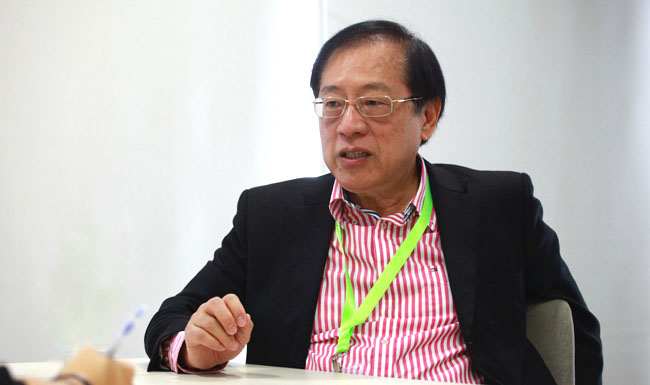
AsianScientist (Jan. 26, 2015) – At a press conference in the lead up to the 2003 Nobel Prize ceremony, a flurry of cameras and reporters descended on two British scientists.
Sir Peter Mansfield, who had jointly won the Nobel Prize in Physiology or Medicine with Paul Lauterbur for their role in the development of magnetic resonance imaging (MRI), calmly explained the various game-changing applications of MRI, including the diagnoses of many diseases and ultimately, lives saved.
All eyes in the room then turned to Sir Anthony Leggett, the year’s winner in Physics, as he was asked to explain the significance of his findings in the somewhat less relatable system of superfluid helium-3 (3He).
“I had to tell them that if you mean in terms of direct practical applicability, I would have to admit that superfluid 3He is the most useless system ever,” Sir Anthony Leggett candidly shared with Asian Scientist Magazine on the sidelines of the Global Young Scientist Summit, held from 18-23rd January, 2015.
“However, by studying superfluid 3He, we’ve been able to develop a number of experimental techniques that could be applied to other systems, in particular, the field of high temperature superconductors which already has yielded practical applications and is likely to have even more in the future.”
Finding a theory to explain a strange phenomenon
While superfluid 3He is not going to directly save your life, it does have a number of intriguing properties. Superfluidity is a state in which matter behaves like a fluid with zero friction, giving it the ability to achieve counterintuitive feats like creeping up the edges of a container, moving against the forces of gravity and surface tension.
“Normal liquid 3He behaves exactly as we thought it ought to, that is, its nuclear magnetic resonance peak was proportional to the external magnetic field and nothing else, so there was absolutely no mystery about the liquid phase. Suddenly, when you move below temperatures like 3mK—three thousandth of a degree above absolute zero—3He becomes a superfluid and starts to behave very differently,” Leggett explained.
In 3He, the electrons are all paired off and form closed shells, and are therefore unable to generate the magnetic field required to explain their strange behaviour. This leaves the nuclei, which are known to have a nuclear magnetic moment, acting like tiny bar magnets that could generate a magnetic field. However, the field generated by single nuclei on their neighbour was still much too small to account for the effect which was seen in the experiments.
“This was really puzzling and I seriously thought that this might be evidence that our standard ideas of quantum mechanics were actually breaking down under the ultra low temperature conditions,” Leggett said.
“So I set out, quite explicitly, to construct a proof that given the standard quantum mechanics this just could not happen. But it didn’t quite work out that way in the end; the answer was much more subtle.”
What was happening was that the atoms of 3He were forming bonds which gave them a strong preference for all pairs to do exactly the same thing at the same time, a phenomenon called quantum phase coherence. This results in the system having to make a choice between one direction of spin or the other.
“This means that the energy difference between these two possible states is not just the strength of the field of a single nuclei, but that value multiplied by the total number of pairs. In that way, we could get a value of the interaction energy which was adequate to account for the experiments. We put in the numbers, and it came out beautifully,” Leggett said.
A question of luck
Reflecting on his career, Leggett recalled a number of serendipitous events which culminated in his Nobel Prize winning discovery, from his unusual decision to do a second undergraduate degree in physics to how the rise of Sputnik convinced his military draft board to let him do it.
He was quick to point out, however, that it is precisely because prize winning discoveries are often lucky that young scientists shouldn’t do research for the sake of prizes.
“It makes no sense whatsoever for young people to think: ‘I want to win the Nobel Prize’,” he stressed. “On the other hand, if I had to advise them, what I think I can do is perhaps try and give them some guidelines as to how to have a career that is intellectually satisfying to them. Whether or not it ends up getting a Nobel Prize, that is certainly a matter of luck. But whether it is satisfying, that is something that one can plan for, at least to a certain extent.”
In fact, Leggett sees his most important legacy not in terms of the prizes he has won, but in how much he has been able to inspire the next generation of physicists.
“I think I’d be happy if my writing could give a wide swathe of younger graduate students a good intuitive understanding of what’s going on in superfluid and superconducting system. To that end, I’ve written a textbook and try to give outreach talks. In some sense, that would be the most valuable thing I can do.”
Asian Scientist Magazine is a media partner of the Global Young Scientists Summit (GYSS@one-north 2015), which took place from 18-23 January, 2015 at Nanyang Technological University, Singapore. GYSS@one-north 2015 is organized by the National Research Foundation of Singapore in collaboration with its partners.
—–
Copyright: Asian Scientist Magazine.
Disclaimer: This article does not necessarily reflect the views of AsianScientist or its staff.












